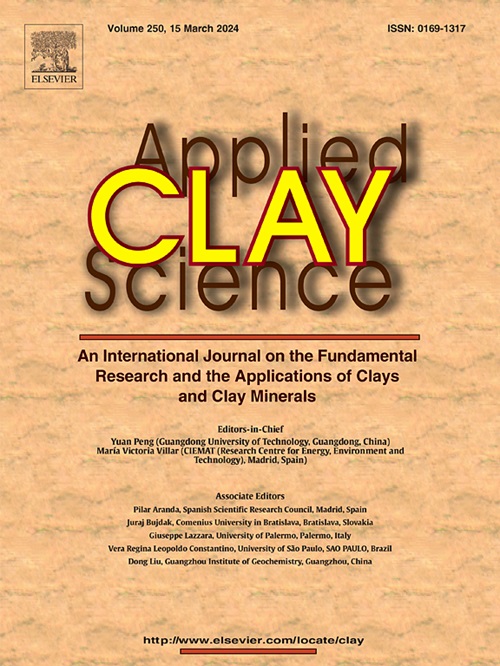Probing subtle alterations of smectite layer charge by the spectroscopic OD method in bentonite from the Alternative Buffer Materials tests in Äspö, Sweden
IF 5.3
2区 地球科学
Q2 CHEMISTRY, PHYSICAL
引用次数: 0
Abstract
The recent and efficient spectroscopic, “O-D (using D2O water) method”, for layer charge (LC) determination of materials containing smectitic, wettable surfaces was used to identify subtle LC changes of thermally reacted samples (between ∼80 and 250 °C) from the Alternative Buffer Material (ABM) tests 2 and 5 conducted at the Äspö Hardrock Laboratory (HRL), Sweden. The tests were in situ intermediate-scale field experiments designed to simulate an engineered barrier around canisters containing radioactive waste within a deep geological repository. The tests consisted of several different bentonites compacted into 31 (ABM2) and 30 (ABM5) discs, stacked vertically around a central heater, and emplaced in a crystalline rock borehole in the HRL. Previous investigations of the ABM2 and 5 bentonites did not reveal specific mineralogical reactions of smectites, which may be observed at temperatures above 100 °C. The data presented in the present study, however, showed LC changes, in the ABM5 test, within the individual bentonite discs along a thermal gradient from the outside edge of the discs toward the heater contact, at which the temperature reached a maximum of 250 °C. Considerably less LC changes were observed for the bentonites in ABM2, in which heating reached a maximum of only ∼140 °C. Moreover, the LC data presented in the present study were found to be consistent with previously obtained cation exchange capacity (CEC) results and explained the observed changes in CEC along the thermal gradients across the discs. Both CEC and LC displayed a strong decreasing trend toward the heater contact in ABM5, and very weak increases toward the heater contact in ABM2. Of the several bentonites used in the tests, those with an initially higher LC, generally showed the greatest decrease of apparent LC after being reacted at high temperatures in the ABM5 package. The bentonites with an initially low to medium smectitic LC, appeared to undergo the least changes at the high temperatures achieved in the ABM5 package. The observed decrease of apparent LC is interpreted as resulting from the adsorption of interlayer cations at the siloxane surface, possibly in the ditrigonal cavity of the tetrahedral sheet, causing partial neutralization of the negative charge of the 2:1 layer. The minute increase in LC in the ABM2 package also showed a correlation with CEC but was within the measurement uncertainty.
用光谱 OD 法探测瑞典阿斯波替代缓冲材料试验中膨润土中奇石层电荷的微妙变化
瑞典Äspö 硬岩实验室(HRL)进行了替代缓冲材料(ABM)试验 2 和试验 5,利用最新的高效光谱法 "O-D(使用 D2O 水)法 "对含有熔融浸润表面的材料进行层电荷(LC)测定,以确定热反应样品(80 ∼ 250 °C)的微妙 LC 变化。这些试验是原位中型野外试验,旨在模拟深层地质处置库中装有放射性废物的罐周围的工程屏障。试验包括将几种不同的膨润土压实成 31 个(ABM2)和 30 个(ABM5)圆盘,围绕中央加热器垂直堆放,并将其放置在 HRL 的结晶岩钻孔中。之前对 ABM2 和 5 膨润土进行的研究并未发现在温度超过 100 ° C 时可能出现的特殊矿物学反应。不过,本研究中提供的数据显示,在 ABM5 试验中,各个膨润土圆盘内的低浓变化是沿着从圆盘外缘向加热器接触处的热梯度变化的,在加热器接触处的温度最高达到 250 °C。在 ABM2 试验中观察到的膨润土 LC 变化要小得多,在该试验中,加热温度最高仅达到 140 °C。此外,本研究还发现 LC 数据与之前获得的阳离子交换容量(CEC)结果一致,并解释了所观察到的 CEC 沿整个圆盘的热梯度变化。在 ABM5 中,阳离子交换容量和低浓度都呈现出向加热器接触面强烈下降的趋势,而在 ABM2 中,向加热器接触面上升的趋势非常微弱。在测试中使用的几种膨润土中,那些最初低浓度较高的膨润土在 ABM5 套装中经过高温反应后,表观低浓度的下降幅度通常最大。在 ABM5 套装中,最初具有低至中等熔融低密度的膨润土在高温下发生的变化似乎最小。观察到的表观低浓度下降可解释为硅氧烷表面吸附了层间阳离子,可能是在四面体薄片的二三元空腔中,导致 2:1 层的负电荷部分中和。ABM2 封装中 LC 的微小增加也显示出与 CEC 的相关性,但在测量的不确定性范围内。
本文章由计算机程序翻译,如有差异,请以英文原文为准。
求助全文
约1分钟内获得全文
求助全文
来源期刊

Applied Clay Science
地学-矿物学
CiteScore
10.30
自引率
10.70%
发文量
289
审稿时长
39 days
期刊介绍:
Applied Clay Science aims to be an international journal attracting high quality scientific papers on clays and clay minerals, including research papers, reviews, and technical notes. The journal covers typical subjects of Fundamental and Applied Clay Science such as:
• Synthesis and purification
• Structural, crystallographic and mineralogical properties of clays and clay minerals
• Thermal properties of clays and clay minerals
• Physico-chemical properties including i) surface and interface properties; ii) thermodynamic properties; iii) mechanical properties
• Interaction with water, with polar and apolar molecules
• Colloidal properties and rheology
• Adsorption, Intercalation, Ionic exchange
• Genesis and deposits of clay minerals
• Geology and geochemistry of clays
• Modification of clays and clay minerals properties by thermal and physical treatments
• Modification by chemical treatments with organic and inorganic molecules(organoclays, pillared clays)
• Modification by biological microorganisms. etc...
 求助内容:
求助内容: 应助结果提醒方式:
应助结果提醒方式:


